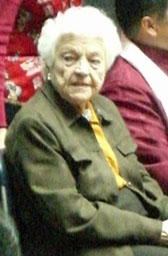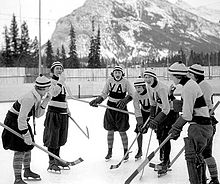Canadian women's ice hockey history
In February 1921, a women's North American championship series was played in conjunction with the Pacific Coast Hockey Association.
Cartwright solicited help from several experienced hockey people including Rhonda Leeman Taylor, Bev Mallory, Carl Noble, and later on, Frank Champion Demers.
[3] In April 1987, Toronto, Ontario hosted the first ever Women's World Championship, though the tournament was not recognized by the International Ice Hockey Federation.
During the tournament, representatives from participating nations met to establish a strategy to lobby the International Ice Hockey Federation (IIHF) for the creation of a Women's World Championship.
Stanley, Canada's sixth Governor General, provided the ice for women's hockey games, transforming a large lawn on the grounds of Rideau Hall into a rink.
Elizabeth Graham would play ice hockey for Queen's University and is credited as being the first goaltender ever to wear a mask for protection.
[12] Abigail "Abby" Hoffman, gold medallist in the 880 yard event at the 1966 Commonwealth Games,[13] first made a name for herself in ice hockey.
[15] During the 1960s, Cookie Cartwright and a group of dedicated students revived the women's ice hockey program at Queen's University.
The Ontario Women's Hockey Association (OWHA) formed in 1975 and, though it was founded on the principles of collegialism (a collective volunteerism), it has shifted toward a professional mandate in more recent years.
[19] In February 1921, Frank Patrick announced a women's international championship series that would be played in conjunction with the Pacific Coast Hockey Association.
At the 1917 Banff Winter Carnival, the Crescents qualified for the championship game but were defeated by the newly formed Calgary Regents.
As Banff carnival champions, the Regents were given the Bernard-Harvey Trophy, which was introduced in the 1917 championship in an attempt to increase the status of the women's competition.
The Dominion Women's Amateur Hockey Association intervened and ask that the Avenue Grills ladies team join the DWAHA.
The team wore used Acadia varsity men's hockey sweaters, and raised funds to play in a few tournaments.
These included: Violet Hall, Sheila Lahey, Gladys Hawkins, Norma Hipel, Ruth Dargel, Elvas Williams, Fay Hilborn, Winnie Makcrow and Eleanor Fairgrieves, Midge Robertson and Marie Bielstein.
[43] Rossland's biggest upset came in 1917 when the club were defeated a ladies team from Grand Forks for the West Kootenay Championship.
[45] At the Banff tournament in 1922, Elizabeth Hinds, became the first woman from British Columbia to score a hat trick in a game Phebe Senkler was captain of the Amazons and her sister Norah played on defence.
In autumn of 1923, the LOHA suffered a setback when the Canadian Amateur Hockey Association held a meeting in Port Arthur.
Atkins wanted Dudley to help increase membership by encouraging ladies teams from Northwestern and Western Ontario to join.
[63] However, in 2019 hundreds of prominent women's players, including Canadian and American Olympians, founded the Professional Women's Hockey Players' Association (PWHPA) and opted to boycott existing leagues, including the NWHL, in pursuit of a unified, financially stable professional league.
[68] The following day, a match between Ottawa and Montreal drew a record crowd for a professional women's game with 8,318 in attendance.
[71] Some well-known players include: Fran Rider was the founding executive director of the Ontario Women's Hockey Association when it was formed in 1975.
[55] In 2015, Rider was inducted into the IIHF Hall of Fame in 2015 in recognition of her substantial impact on the growth and development of the modern game of women's hockey.
She proceeded by writing to Mississauga mayor Hazel McCallion,[78] Canadian Prime Minister Brian Mulroney, and IOC President Juan Antonio Samaranch.
[12] At one time, she was a board member of the Ontario Women's Hockey League, and was instrumental in getting the Hershey Centre built for the city of Mississauga.
In 1981, Justine Blainey won a spot on a Metro Toronto Hockey League Team (MTHL) but was denied the chance to play.
[81] Blainey played for the Toronto Lady Blues women's ice hockey program in the 1990s and assumed another activist role.
In 1993, (although the Lady Blues won 13 of the last 15 provincial championships), a task force recommended that the University of Toronto cut the team for financial reasons.
Jack Lacey became involved again as he supplied a set of custom-painted pink-coloured hockey sticks to the Hornettes for use in the tournament.
In 1985, the local entry was called Vanatters Panthers with Dina Celotto the MVP and Lynn McCreary, top goaltender.











